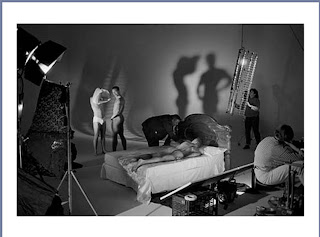Queer Studies: Race and Religion Curatorial Project
www.racereligionfilm.blogspot.com
Celeste Torres, Kamran Payman
The battle for queer space within social communities of race and religion is exposed in a variety of styles and perspectives in film production. Whether an audio book, a four-minute short or full-length documentary, queer content in such films extends to political and spiritual planes to address issues of identity (both communal and personal) that often clash with an individual’s homosexuality. Each of the productions below are described in reference to this relationship. Finally, following these descriptions are summaries posted by each curator and their respective production.
Renowned drag artist, RuPaul stars as the title character in this short film by Fenton Bailey and Randy Barbato. Upon first glance, Shantay comes off simply as a campy comedy. However, while the film is very much that, it does deal with the intersection of race and homosexuality due to the fact that RuPaul is a drag performer and a person of color. Within the heightened reality of the film, Shantay is actually a woman, but the audience knows that the character is actually RuPaul in drag, thus, giving the film its queer edge and crossing these two identities. What this intersection of race and queerness symbolizes in this film is a positive image of both an individual of color and one that is queer. In short, it is a positive portrayal of a queer person of color.
Looking for Langston is a short which was created in 1989 which gives perspective to the black gay man lifestyle in coping with homophobia and white racism in the 1920’s this is not a biography but a memoriam to Langston Hughes. Langston is a caricature of black men who struggle for social acceptance and tolerance and yet are denied by their white counterpart. Langston Hughes battles with his sexuality and the ramifications of being black and gay in the 1920’s.
Homosexuality as shown in For the Bible Tells Me So is considered an abomination according to biblical text for the majority of the Christian community. There is no space for a queer identity. Reform is occurring on a small scale in an effort to validate queer believers as being part of the church. The queer space is slowly growing within Christianity and will hopefully extend to a national and even global scale in the future to fully accept gay individuals of faith as part of a larger queer community.
In the art dialogue Color Bonita, the ways in which both race and religion intersect with homosexual identity of gay men within the Latino/a culture in
The idea for Tongues Untied began as a video about the 'Other Countries Workshop', a New York-based poetry workshop for black gay men. As a non-poet, Riggs found himself drawn to their work because it spoke directly to his own experience. Through this, he became increasingly aware of feeling alienated by classical poetic form, which itself seemed to be speaking through and from the voice of a foreign and oppressing culture. Riggs' focus shifted to a concern with the issue of voices and speaking, and how to do so from and about black gay culture. Riggs simultaneously celebrates the innovation and expression of the flamboyant gestures and acid wit of snapping, while also critiquing the positioning of black gay culture as an ethnographic subject. Similarly, he presents dance as an expression of cultural resistance, community building and cultural affirmation.
BOMgAY implies that the strange and paradoxical aspects of life and homosexuality are actually not as strange as society considers them by virtue of the fact that they are not new phenomenon that have developed but always have existed. This paradoxical nature is expressed both concretely and in a philosophical manner. Concretely we see a justification in the introduction; “Fifty-million people in














